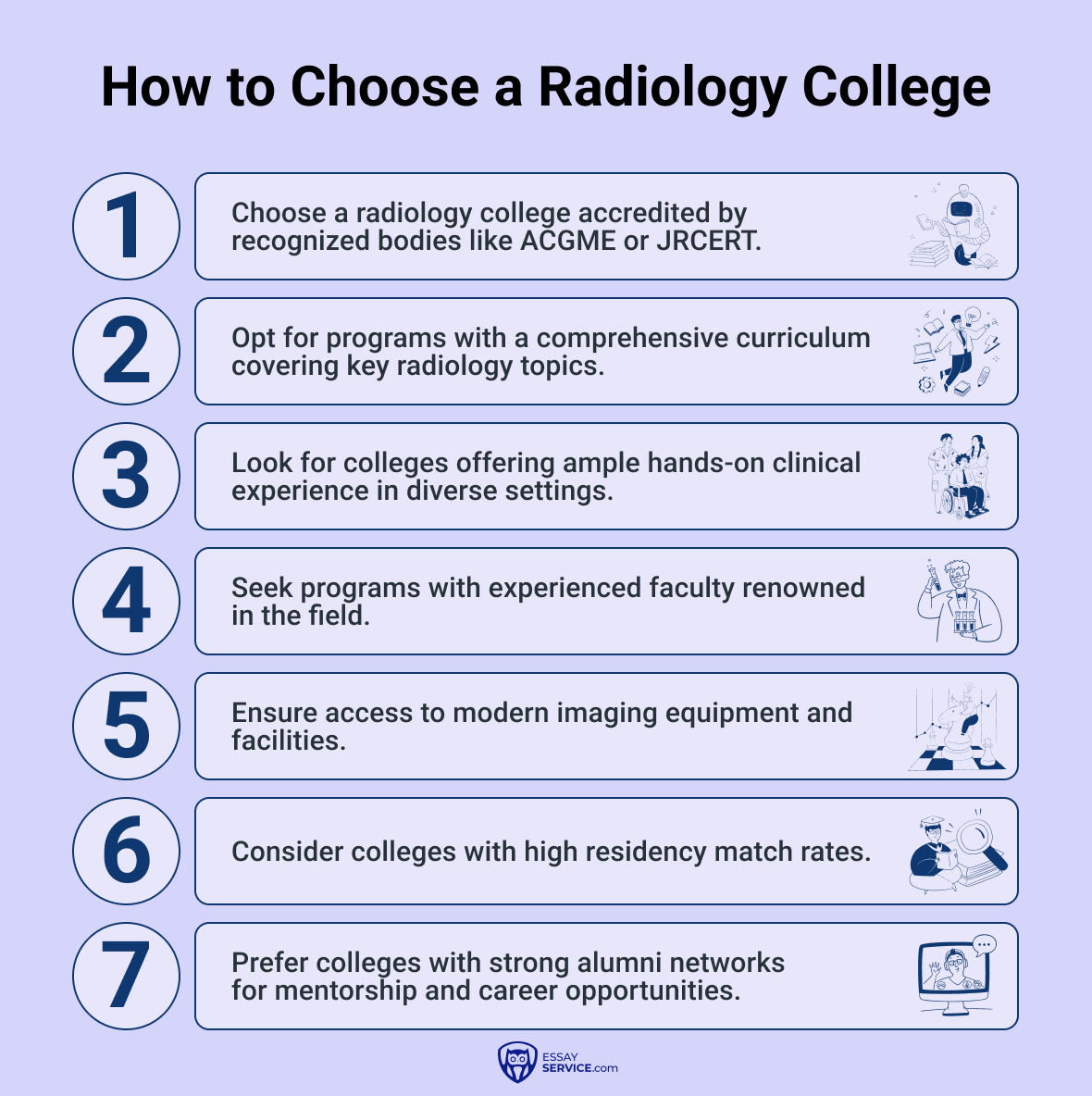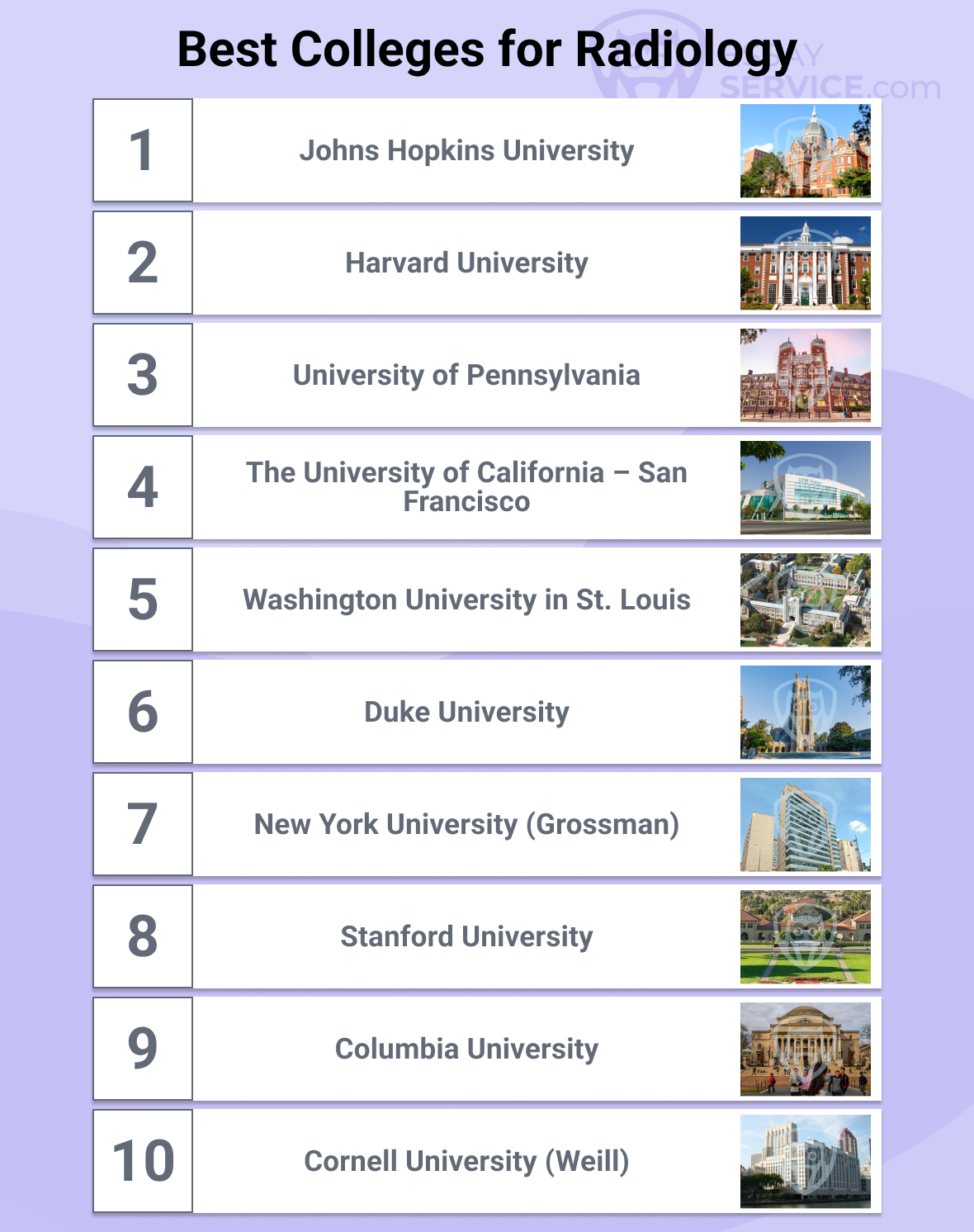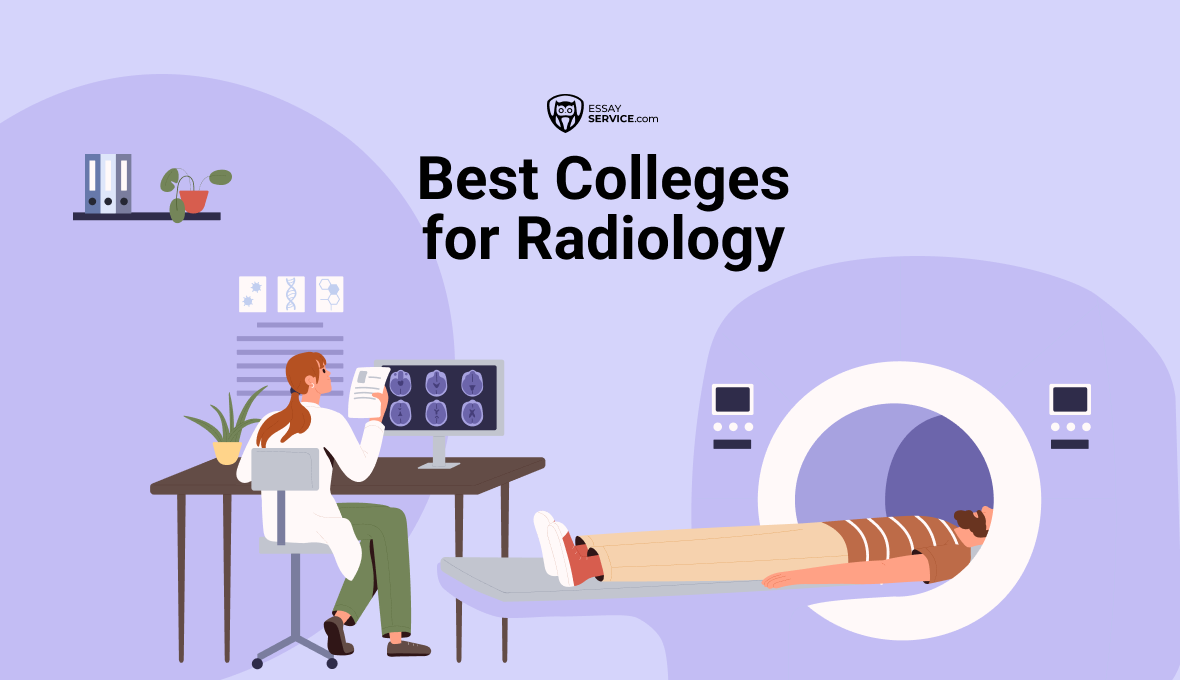In radiology, where technology and medical imaging play big roles in healthcare, picking the right college is super important. This article written by experts from our college admission essay writing service is about helping you find the best colleges with radiology programs. We'll explore top schools known for their great curriculum, awesome facilities, top-notch teachers, and chances to get real hands-on experience.
What is Radiology?
Radiology is a branch of medicine that involves the use of medical imaging techniques to diagnose and treat diseases and injuries within the body. It encompasses various imaging modalities such as X-rays, computed tomography (CT), magnetic resonance imaging (MRI), ultrasound, and nuclear medicine imaging. Radiologists, doctors specializing in this field, interpret medical images to identify abnormalities, diseases, or injuries, helping other healthcare professionals make accurate diagnoses and develop treatment plans. Radiology is pivotal in virtually every area of medicine, from detecting fractures and tumors to guiding surgical procedures and monitoring treatment progress.

Diagnostic Radiology
Diagnostic radiology programs specialize within the broader discipline of radiology, focusing on using medical imaging techniques to diagnose diseases, injuries, and conditions. It involves interpreting various modalities such as X-rays, computed tomography (CT), magnetic resonance imaging (MRI), medical ultrasound, and nuclear medicine scans to identify abnormalities or changes within the body. Diagnostic radiologists work closely with other healthcare professionals to assess patient symptoms, order appropriate studies, interpret the results, and provide accurate diagnoses. They are critical in helping patients receive timely and effective medical care by providing essential information for treatment planning and monitoring. Diagnostic radiology exams usually include:
- Computed Tomography (CT).
- Fluoroscopy.
- Magnetic Resonance Imaging (MRI).
- Magnetic Resonance Angiography (MRA).
- Mammography.
- Nuclear Medicine (Thyroid Scan, Bone Scan, Thallium Cardiac Stress Test).
- X-rays.
- Positron Emission Tomography (PET Scan, PET Imaging, PET-CT).
- Ultrasound.
Interventional Radiology
Interventional radiology program (IR) is a specialized branch of radiology that uses imaging techniques to guide minimally invasive procedures for diagnosing and treating various conditions. Unlike traditional surgery involving large incisions, interventional radiology procedures use small instruments, such as needles and catheters, inserted through the skin and guided by real-time imaging, such as X-ray, CT, MRI, or ultrasound. Interventional radiologists are trained to perform a wide range of medical procedures, including angiography, embolization, biopsies, drain insertions, and tumor ablations. IR techniques offer patients shorter recovery times, less pain, and lower risks than conventional surgery, making them an increasingly popular choice for many medical interventions. The main types of interventional radiology procedures include:
- Angiography, Angioplasty, and Stent Placement.
- Embolization.
- Cancer Treatments (such as Tumor Embolization, Chemoembolization, and Y-90 Radioembolization).
- Tumor Ablation (including Radiofrequency Ablation, Cryoablation, and Microwave Ablation).
- Vertebroplasty and Kyphoplasty.
- Needle Biopsies.
- Breast Biopsy (utilizing Stereotactic or Ultrasound Techniques).
- Uterine Artery Embolization.
- Feeding Tube Replacement.
- Venous Access and Catheter Placement (including Ports and PICCs).
Subspecialties of Radiology
Radiology encompasses various subspecialties, each focusing on specific imaging and medical care areas. Some common radiology subspecialties include:
- Neuroradiology: Specializes in imaging of the brain, spine, head, and neck.
- Musculoskeletal Radiology: Focuses on imaging of bones, joints, muscles, and soft tissues.
- Pediatric Radiology: Concentrates on imaging children and infants, addressing unique pediatric conditions.
- Cardiovascular Radiology: Centers on imaging of the heart and blood vessels, including angiography and cardiac MRI.
- Breast Imaging: Specializes in imaging and diagnosing breast diseases, including mammography and breast ultrasound.
- Abdominal Radiology: Focuses on imaging the abdomen and pelvis, including gastrointestinal and genitourinary systems.
- Interventional Radiology: Involves minimally invasive imaging-guided procedures, such as angiography and tumor ablation.
- Nuclear Medicine: Utilizes radioactive tracers for diagnostic imaging and treatment of diseases.

Average Salary of Radiologists
In the United States, the average annual salary for radiologists after college can vary significantly based on several factors. According to data from the American Medical Group Association (AMGA) and other sources, radiologists typically earn between $300,000 and $500,000 annually. However, salaries can exceed $600,000 or more for radiologists with extensive experience, subspecialty training, or leadership roles. Location also plays a significant role in salary, with radiologists in urban areas often earning higher salaries than those in rural areas.
For example, radiologists in metropolitan areas like New York City or Los Angeles may earn above-average salaries due to higher living costs and demand for medical services. Additionally, radiologists employed by college medical centers or large healthcare organizations may receive additional benefits such as retirement plans, health insurance, and academic stipends. Overall, the salary of radiologists reflects their specialized skills, expertise, and contributions to patient care and medical imaging.
Best Colleges for Radiology

The best schools for radiology stand out because they offer top-notch education, advanced facilities, experienced teachers, and plenty of hands-on training. These schools ensure college students learn everything they need about medical imaging, from X-rays to MRI scans. They also allow college students to practice using the latest technology to prepare for the real world. Plus, these schools often have opportunities where college students can discover new things about radiology. With these schools, college students graduate fully prepared to become skilled radiologists and make a difference in healthcare.
Johns Hopkins University

Johns Hopkins University's radiology program is particularly distinguished for its advanced medical techniques and pioneering initiatives. The institution houses avant-garde facilities like the Johns Hopkins Medicine Department of Radiology and Radiological Science, equipped with modern MRI, CT, PET-CT, and ultrasound machines, providing college students with hands-on experience with the latest diagnostic technologies.
Furthermore, the college's emphasis on translational research offers unique opportunities for college students to engage in projects that bridge the gap between laboratory discoveries and clinical applications. For instance, the Johns Hopkins Center for Imaging Science collaborates with radiologists, medical engineers, and computer scientists to develop innovative algorithms and software, providing college students with exposure to groundbreaking research at the intersection of technology and healthcare.
Moreover, Johns Hopkins Medical School offers a robust clinical training program that grants college students access to a diverse patient population, including rare and complex cases, at renowned medical institutions like Johns Hopkins Hospital and Johns Hopkins Bayview Medical Center. Through clinical rotations and electives, college students gain practical experience in interpreting images, conducting procedures, and collaborating with multidisciplinary healthcare teams, preparing them for the challenges and opportunities they'll encounter in their careers as radiologists.
Dr. Elliot K. Fishman
M.D.
Professor of Radiology and Oncology: Dr. Fishman is a prominent figure in abdominal imaging and computer-aided diagnosis.
Dr. Karen M. Horton
M.D.
Professor of Radiology and Radiological Science: Dr. Horton is an expert in breast imaging and intervention.
Dr. Pamela T. Johnson
M.D.
Associate Professor of Radiology and Radiological Science: Dr. Johnson specializes in neuroradiology and head and neck imaging.
Dr. David M. Yousem
M.D., M.B.A.
Professor of Radiology and Radiological Science: Dr. Yousem is a renowned neuroradiologist with expertise in neuroimaging and head and neck radiology.
Harvard University

Harvard University offers an exceptional medical school with a radiology program bolstered by its world-renowned teaching hospitals, with Massachusetts General Hospital (MGH) and Brigham and Women's Hospital (BWH) at the forefront. MGH, affiliated with Harvard Medical School, ranks consistently among the top hospitals in the nation for its radiology services, handling over 450,000 exams annually. Brigham and Women's Hospital, a Harvard teaching hospital, boasts cutting-edge technologies such as 3T MRI, PET-CT, and advanced ultrasound modalities, providing college students with hands-on experience with superb equipment.
Furthermore, Harvard's radiology program benefits from its distinguished faculty, many of whom are leaders in their respective subspecialties. Notably, the Department of Radiology at MGH comprises over 100 medical faculty members, including numerous recipients of prestigious awards such as the RSNA Gold Medal and the Nobel Prize. Students have the opportunity to learn from these luminaries, engaging in research projects that contribute to the advancement of the field. Harvard's commitment is exemplified by its robust funding, with over $1.5 billion in grants awarded annually across its affiliated hospitals and institutions. This wealth of medical resources enables college students to participate in groundbreaking endeavors, from developing novel techniques to investigating the role of imaging in precision medicine and artificial intelligence applications in radiology.
Dr. Ramin Khorasani
M.D., M.P.H.
Professor of Radiology, Harvard Medical School: Dr. Khorasani specializes in informatics and has made significant contributions to the field of radiology through his work in artificial intelligence and machine learning.
Dr. Garry Choy
M.D., M.B.A.
Associate Professor of Radiology, Harvard Medical School: Dr. Choy is an expert in cardiothoracic imaging and has expertise in medical education.
Dr. Pamela A. Johnson
M.D.
Associate Professor of Radiology, Harvard Medical School: Dr. Johnson specializes in breast imaging and women's health.
Dr. Aaron Sodickson
M.D., Ph.D.
Professor of Radiology, Harvard Medical School: Dr. Sodickson is a leader in emergency and trauma radiology.
University of Pennsylvania

The University of Pennsylvania (Penn) offers a top-tier radiology program that distinguishes itself through its state-of-the-art medical facilities, renowned faculty, and leading-edge initiatives. Penn's Perelman School of Medicine is affiliated with the Hospital of the University of Pennsylvania (HUP), which houses one of the most advanced radiology departments in the nation. With over 500,000 imaging studies performed annually, including specialized medical procedures like interventional radiology and nuclear medicine, college students at Penn gain exposure to a diverse range of cases that prepare them for real-world clinical practice. The department's commitment to innovation is evident through its utilization of advanced imaging modalities such as PET-MR and molecular imaging, providing college students with hands-on experience with the latest technologies shaping the future of radiology.
Moreover, Penn's radiology program benefits from its esteemed faculty, who are leaders in their respective subspecialties and hold key positions in national radiological societies. The department boasts over 90 full-time faculty members, several of whom have been recognized with prestigious awards such as the RSNA Gold Medal and the American Roentgen Ray Society Gold Medal. Students can learn from these distinguished experts through mentorship programs, collaborations, and clinical rotations. Penn's commitment to medical excellence is underscored by its substantial funding, with over $450 million in sponsored research expenditures annually, supporting groundbreaking projects in areas such as biomarkers, image-guided therapy, and radiomics. Through these initiatives, Penn equips college students with the knowledge, skills, and resources necessary to become leaders in radiology.
Dr. Mary J. Salvatore
M.D.
Associate Professor of Radiology, University of Pennsylvania: Dr. Salvatore specializes in neuroradiology and has extensive experience in imaging of the brain and spine.
Dr. Benjamin M. Chow
M.D.
Professor of Radiology, University of Pennsylvania: Dr. Chow is an expert in cardiovascular imaging and interventional radiology.
Dr. Emily F. Conant
M.D.
Professor of Radiology, University of Pennsylvania: Dr. Conant is a leader in breast imaging and has made significant contributions to the field of mammography.
Dr. Ethan J. Halpern
M.D
Professor of Radiology, University of Pennsylvania: Dr. Halpern specializes in abdominal imaging and has gastrointestinal and genitourinary radiology expertise.
The University of California – San Francisco

The University of California – San Francisco (UCSF) is a premier institution for studying radiology due to its outstanding faculty expertise, innovative endeavors, and access to the latest clinical facilities. UCSF's Department of Radiology and Biomedical Imaging is home to renowned faculty members who are leaders in their fields, with many holding prestigious positions in national radiological societies and receiving accolades such as the Gold Medal from the Radiological Society of North America (RSNA). With over 80 full-time faculty members, including pioneers in neuroradiology, musculoskeletal and breast imaging, UCSF offers college students unparalleled opportunities for mentorship and collaboration. Moreover, UCSF's commitment to diversity and inclusion is reflected in its faculty composition, with a significant percentage of medical students being women and underrepresented minorities, providing college students with diverse perspectives and role models.
Furthermore, UCSF's radiology program is distinguished by its robust research initiatives and access to prolific technologies. The college is home to the UCSF Imaging Center, which houses advanced modalities such as PET-MR, 3T MRI, and molecular imaging, enabling college students to engage in trailblazing research projects and clinical trials. UCSF's close collaboration with industry partners and institutions fosters interdisciplinary innovation in artificial intelligence, radionics, and precision medicine, positioning college students at the forefront of technological advancements in radiology. Additionally, UCSF's clinical training program offers college students exposure to a diverse patient population at its affiliated hospitals, including UCSF Medical Center and Zuckerberg San Francisco General Hospital, providing hands-on experience with various diagnostic and interventional procedures.
Dr. Thomas Hope
M.D.
Professor of Radiology and Chief of Nuclear Medicine, UCSF: Dr. Hope is a renowned expert in nuclear medicine and molecular imaging.
Dr. Soonmee Cha
M.D.
Professor of Radiology and Vice Chair of Education, UCSF: Dr. Cha specializes in neuroradiology and has expertise in advanced imaging techniques for neurological disorders.
Dr. Judy Yee
M.D.
Professor of Radiology and Vice Chair of Radiology, UCSF: Dr. Yee is a leader in gastrointestinal imaging and has made significant contributions to colorectal cancer screening.
Dr. Thomas Link
M.D., Ph.D.
Professor of Radiology and Chief of Musculoskeletal Imaging, UCSF: Dr. Link specializes in musculoskeletal imaging and has expertise in diagnosing and treating orthopedic conditions.
Washington University in St. Louis

Washington University in St. Louis offers a noteworthy radiology program renowned for its distinguished faculty and clinical facilities. The Mallinckrodt Institute of Radiology, affiliated with the Washington University School of Medicine, is one of the leading radiology departments in the country. With over 100 faculty members, including numerous recipients of prestigious awards such as the Gold Medal from the Radiological Society of North America (RSNA), Washington University’s medical school provides college students with unparalleled mentorship and collaboration opportunities. Additionally, the Mallinckrodt Institute is home to advanced technologies, including PET-CT, 3T MRI, and molecular imaging, enabling college students to engage in innovative research projects and gain hands-on experience with novel modalities.
Moreover, Washington University's radiology medical program emphasizes interdisciplinary collaboration and translational research, positioning college students at the forefront of technological advancements. Students can access resources and funding to support groundbreaking endeavors through partnerships with industry leaders and institutions, such as the Institute of Clinical and Translational Sciences. Washington University's commitment to diversity and inclusion is reflected in its faculty composition, with a significant percentage of students being women and underrepresented minorities, providing college students with diverse perspectives and role models. Furthermore, the college's clinical training program offers college students exposure to a diverse patient population at its affiliated hospitals, including Barnes-Jewish Hospital and St. Louis Children's Hospital, where they gain invaluable hands-on experience in diagnostic and interventional radiology procedures.
Dr. Richard L. Wahl
M.D.
Professor of Radiology and Director of the Division of Nuclear Medicine: Dr. Wahl is a distinguished expert in nuclear medicine and molecular imaging.
Dr. Pamela K. Woodard
M.D.
Professor of Radiology and Chief of Cardiothoracic Imaging: Dr. Woodard specializes in cardiothoracic imaging and has expertise in imaging of cardiovascular and pulmonary diseases.
Dr. Fred H. Lin
M.D.
Professor of Radiology and Chief of Neuroradiology: Dr. Lin is a leader in neuroradiology and has extensive experience in imaging of the brain and spine.
Dr. Carolyn C. Meltzer
M.D.
Professor of Radiology and Chief of Nuclear Medicine and Molecular Imaging: Dr. Meltzer is an expert in nuclear medicine and molecular imaging.
Duke University

Duke University offers a premier radiology program distinguished by its world-class faculty, research facilities, and comprehensive clinical training opportunities. The Duke University Medical Center, home to the Department of Radiology, is consistently ranked among the top hospitals in the nation for its extraordinary patient care and innovative endeavors. With over 80 faculty members, including leaders in various subspecialties such as cardiovascular imaging, neuroradiology, and interventional radiology, Duke provides college students with unparalleled access to mentorship and collaboration. Notably, many faculty members hold prestigious positions in national radiological societies and have received accolades, such as the Gold Medal from the Radiological Society of North America (RSNA), reflecting Duke's commitment to excellence in the field.
Furthermore, Duke's radiology program emphasizes interdisciplinary collaboration and translational research, positioning college students at the forefront of technological advancements. The Duke Clinical Research Institute, one of the largest academic organizations globally, offers college students opportunities to engage in groundbreaking projects and clinical trials. Duke's facilities, including PET-MR, 3T MRI, and advanced CT scanners, also enable students to gain hands-on experience with modalities. Through clinical rotations at Duke University Hospital and affiliated medical centers, college students encounter a diverse range of patient cases. They can participate in diagnostic and interventional procedures under the guidance of experienced faculty. Duke's commitment to diversity and inclusion is further demonstrated by its efforts to foster a supportive learning environment that values diverse perspectives and experiences in radiology education and practice.
Dr. James A. Brink
M.D.
Professor of Radiology and Chairman of the Department of Radiology: Dr. Brink is a distinguished expert in abdominal imaging and has made significant contributions to radiology.
Dr. Pamela T. Johnson
M.D.
Professor of Radiology and Chief of Breast Imaging: Dr. Johnson specializes in breast imaging and has extensive experience in the early detection and diagnosis of breast cancer.
Dr. Evan S. Siegelman
M.D.
Professor of Radiology and Chief of Neuroradiology: Dr. Siegelman is an expert in neuroradiology and has brain and spine imaging expertise.
Dr. William W. Boonn
M.D.
Professor of Radiology and Chief of Musculoskeletal Radiology: Dr. Boonn specializes in musculoskeletal imaging and has expertise in diagnosing and treating orthopedic conditions.
New York University (Grossman)

New York University's Grossman School of Medicine offers a standout radiology program known for its superior faculty and extensive clinical opportunities. The Department of Radiology at NYU Grossman School of Medicine is home to over 100 faculty members who are leaders in the field, with many holding prestigious positions in national and international radiological societies. Notably, the medical department boasts many RSNA Gold Medal recipients, underscoring its commitment to excellence in radiology education and practice. With access to renowned faculty mentors, college students benefit from personalized guidance and mentorship, enhancing their learning experience and preparing them for successful careers in radiology.
Moreover, NYU Grossman School of Medicine prioritizes innovation in radiology, providing college students with opportunities to engage in groundbreaking projects. The Department of Radiology is affiliated with the NYU Langone Health system, which includes Tisch Hospital, a designated Magnet® hospital, and the Ronald O. Perelman Center for Emergency Services, equipped with profound facilities. Through collaborations with industry partners and research institutions, NYU Grossman School of Medicine drives interdisciplinary initiatives in artificial intelligence, precision medicine, and advanced techniques. Additionally, college students have access to a diverse patient population, with NYU Langone Health serving as a major academic medical center in New York City, allowing college students to gain hands-on experience with various diagnostic and interventional radiology procedures.
Dr. Michael P. Recht
M.D.
Professor and Chairman of the Department of Radiology: Dr. Recht is a distinguished expert in musculoskeletal imaging and has made significant contributions to the field of radiology.
Dr. Hedvig Hricak
M.D., Ph.D.
Professor of Radiology and Chair Emeritus of the Department of Radiology: Dr. Hricak is an internationally renowned expert in oncologic imaging.
Dr. Lawrence H. Schwartz
M.D.
Professor of Radiology and Chief of the Division of Nuclear Medicine: Dr. Schwartz is an expert in nuclear medicine and molecular imaging.
Dr. Michael L. Marin
M.D.
Professor of Radiology and Chief of the Division of Vascular and Interventional Radiology: Dr. Marin specializes in vascular and interventional radiology.
Stanford University

Stanford University's radiology program is distinguished by its paramount faculty, with over 120 board-certified radiologists, many of whom are leaders in their subspecialties. Notably, Stanford's Department of Radiology is consistently ranked among the top nationwide, with medical faculty members receiving numerous accolades, including 14 Gold Medals from the RSNA. The department's faculty-to-student ratio ensures personalized mentorship, with faculty actively involved in teaching and research. For instance, Dr. Sanjiv Sam Gambhir, a pioneer in molecular imaging, leads Stanford's Precision Health and Integrated Diagnostics Center, driving innovations in early disease detection through advanced techniques.
Furthermore, Stanford's radiology program offers unparalleled opportunities, with over $26 million in annual funding supporting groundbreaking projects. The college's Canary Center for Cancer Early Detection is a hub for innovative research, developing novel imaging technologies for early cancer detection. Additionally, Stanford's proximity to Silicon Valley fosters collaborations with industry leaders, leading to advancements in artificial intelligence applications in radiology. Students benefit from hands-on experience with modalities at Stanford Health Care, a Magnet-designated hospital known for its comprehensive patient care. Stanford College provides students with a unique and enriching educational experience in radiology through a combination of esteemed faculty and innovative clinical excellence.
Dr. Sanjiv Sam Gambhir
M.D., Ph.D.
Professor and Chair of the Department of Radiology: Dr. Gambhir is a renowned expert in molecular imaging and has made significant contributions to the field of radiology.
Dr. Daniel L. Rubin
M.D., M.S.
Associate Professor of Radiology and Biomedical Data Science: Dr. Rubin is an imaging informatics and machine learning expert.
Dr. Sandy Napel
Ph.D.
Professor of Radiology and Director of the Radiology Informatics Laboratory: Dr. Napel specializes in medical imaging and computer-aided diagnosis.
Dr. Kimberly Kallianos
M.D.
Associate Professor of Radiology: Dr. Kallianos is an expert in thoracic imaging and diagnosing and treating lung diseases.
Columbia University

Columbia University is a top choice for studying radiology due to its peerless faculty expertise and access to genuine clinical facilities. The Department of Radiology at Columbia University Irving Medical Center boasts over 70 faculty members who are leaders in their respective subspecialties, with many holding prestigious positions in national radiological societies and receiving accolades such as the Gold Medal from the Radiological Society of North America (RSNA). Notably, Columbia's faculty includes pioneers in neuroradiology, musculoskeletal and interventional radiology, providing college students with unparalleled opportunities for mentorship and collaboration. With access to renowned experts and a low faculty-to-student ratio, students benefit from personalized instruction and medical guidance, enhancing their learning experience and preparing them for successful careers in radiology.
Moreover, Columbia College's radiology program is characterized by its commitment to excellence and innovation. The Department of Radiology conducts groundbreaking research in imaging biomarkers, molecular imaging, and artificial intelligence, with annual funding exceeding $20 million. Columbia's Imaging Science and Engineering Laboratory, equipped with state-of-the-art technologies such as PET-CT, 3T MRI, and advanced CT scanners, is a hub for interdisciplinary collaborations. Additionally, Columbia's affiliation with NewYork-Presbyterian Hospital, one of the nation's premier academic medical centers, provides college students access to a diverse patient population and extensive clinical training opportunities. Columbia College offers an unparalleled educational environment for students aspiring to excel in radiology.
Dr. William Bradlow
M.D.
Professor and Chair of the Department of Radiology: Dr. Bradlow is a distinguished expert in neuroradiology and has made significant contributions to radiology.
Dr. Elizabeth Morris
M.D.
Professor of Radiology and Chief of Breast Imaging: Dr. Morris specializes in breast imaging and has extensive medical experience in breast cancer detection and diagnosis.
Dr. Thomas Payne
M.D.
Professor of Radiology and Chief of Neuroradiology: Dr. Payne is an expert in neuroradiology and has expertise in brain and spine imaging.
Dr. John Hodgson
M.D.
Professor of Radiology and Chief of Interventional Radiology: Dr. Hodgson specializes in interventional radiology and has medical expertise in minimally invasive treatments for vascular diseases.
Cornell University (Weill)

Weill Cornell Medicine's radiology program boasts over 80 board-certified faculty members and many internationally recognized medical experts in their subspecialties. Notably, the department's faculty includes 5 members who are Fellows of the American College of Radiology (FACR), showcasing their first-rate expertise and contributions to the field. With a faculty-to-student ratio that facilitates personalized mentorship, college students at Weill Cornell benefit from direct access to esteemed radiologists actively involved in research and clinical practice.
Moreover, Weill Cornell's commitment to medical research excellence is reflected in its robust funding and groundbreaking endeavors. The department receives over $20 million in annual funding, supporting innovative projects in radiology, such as imaging biomarkers, molecular imaging, and artificial intelligence applications. Notably, Weill Cornell is home to the Citigroup Biomedical Imaging Center, a revolutionary facility equipped with advanced modalities such as PET-MR and 3T MRI, providing college students with hands-on medical experience conducting groundbreaking research. Additionally, Weill Cornell's affiliation with NewYork-Presbyterian Hospital, one of the nation's top-ranked hospitals, ensures that college students have access to a diverse patient population and comprehensive clinical training opportunities in diagnostic and interventional radiology.
Dr. Hedvig Hricak
M.D., Ph.D.
Chair of the Department of Radiology: Dr. Hricak is a renowned medical expert in oncologic imaging and has made significant contributions to radiology.
Dr. Michael Recht
M.D.
Professor of Radiology and Vice Chair for Clinical Research: Dr. Recht is an expert in musculoskeletal imaging and has medical expertise in diagnostic and interventional radiology.
Dr. Hebert A. Medina
M.D.
Professor of Radiology and Chief of Neuroradiology: Dr. Medina specializes in neuroradiology and has extensive experience in imaging of the brain and spine.
Dr. Elizabeth A. Morris
M.D.
Professor of Radiology and Chief of Breast Imaging: Dr. Morris is an expert in breast imaging and has expertise in the early detection and diagnosis of breast cancer.



.webp)
